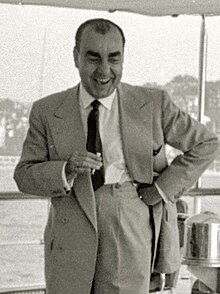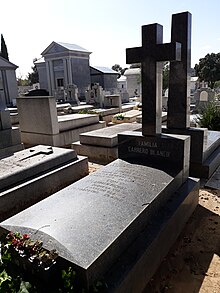Luis Carrero Blanco
Luis Carrero Blanco (born March 4, 1904 in Santoña , Cantabria , † December 20, 1973 in Madrid ) was a Spanish military ( admiral ) and politician . He was considered the Gray Eminence of Franquism and the right hand of the dictator Francisco Franco . From this he was sworn in 1973 as head of government . He died six months later in an ETA assassination attempt .
Military career until the end of the Spanish Civil War
Carrero Blanco entered the Escuela Naval Militar de Oficiales , the Naval School of the Navy , in 1918 and held the rank of officer from 1922. From 1924 to 1926 he took part in the Rif War in Morocco and then specialized in submarines . From 1934 he taught at the Maritime School in Madrid. When the Spanish Civil War broke out , he fled to the embassies of Mexico and France for fear of republican militias . In June 1937 he managed to reach territory occupied by nationalist troops. During the war he was in command of the destroyer Huesca and later of the submarine General Sanjurjo . He then rose to become Chief of Staff of the Navy.
Political Positions in World War II
During the Second World War , he took the position of neutrality for Spain and stood in opposition to the Falangist Foreign Minister Ramón Serrano Súñer , who demanded entry into the war on the side of the Axis powers . While Serrano Súñer lost his government office in 1942, Carrero Blanco gradually became Franco's confidante. In 1941 he was appointed State Secretary .
In 1941 he published the book España y el mar , in which his tendency towards anti-Jewish conspiracy theories becomes apparent: “The world ... is in an uninterrupted war, which is essentially religious in nature. It is the struggle of Christianity against Judaism. A war of life and death, as it is inevitable in the struggle of good against evil, truth against lies, of light against darkness. In this centuries-old struggle, Judaism has understood how to resort to means of all kinds ... the goal is always the same: destroy, annihilate, degrade everything that Christian civilization represents in order to build the utopian Zionist empire of the chosen people on its ruins . "
Political activity after the Second World War
In 1951 Carrero Blanco was appointed Minister of the President. In this office he worked as a coordinator between the various ministries and head of state and government Franco. He was therefore directly involved in all major political developments. He helped to suppress the political influence of the Falange and initiated a fundamental reform of the administrative apparatus. At the end of the 1950s he supported the reorientation of economic policy and the conditional economic opening of the country to Europe. He advocated a policy of mainly economic modernization, which, however, was clearly bounded by Franquism. Democratic and social liberalization tendencies had no place in it.
In 1963 Carrero Blanco was promoted to Vice Admiral, in 1966 to Admiral. In 1967 Franco appointed him deputy head of government. Carrero Blanco increasingly took over government duties from Franco. On June 11, 1973, he was sworn in as Franco's successor as head of government. The 80-year-old Franco officially withdrew from the operational government business and only acted as head of state . Carrero Blanco, who had previously participated in prominent positions in the plans for the transfer of the regime to a monarchy with King Juan Carlos I , was seen as a “strong man” and a guarantor of political continuity in Spain after Franco's death.
The assassination attempt on December 20, 1973
In fact, Carrero Blanco died almost two years before Franco: On December 20, 1973, an underground bomb exploded under his unarmored car in Madrid. The force of the explosion was so violent that his car was thrown over the roof of a five-story house next to the San Francisco de Borja church before landing on a terrace on the second floor. Carrero Blanco had attended morning mass in the church. He and his bodyguard died on the spot in the explosion, and his driver died after they were hospitalized. Four other people were injured and the damage to the street, home and numerous parked cars was considerable. The attack took place fifteen minutes before the start of a trial (known as “Proceso 1001”) against ten detained activists from the underground Comisiones Obreras union.
The Basque - separatist terrorist group ETA known in several communiqués on the attack (which of them so-called "Operación Ogro" - el ogro , German the ogre , was among the separatists Carrero Blanco's nickname). ETA called the murder an act of self-defense by the Basque people against their decades of oppression by Franquism. With the attack, the aim was to promote the conflict between hardliners - like Carrero Blanco - and reform-minded forces within the Francoist leadership. Posthumously Carrero Blanco was made Duque (Duke) in 1973, the title inherited by his son Luis (* 1930).
literature
- Javier Tusell (with the assistance of Genoveva García Queipo de Llano): Carrero. La eminencia gris del régimen de Franco , Madrid: Ediciones Temas de Hoy, 1993 ( ISBN 84-7880-347-5 ).
- Carlos Estévez / Francisco Mármol: Carrero, las razones ocultas de un asesinato , Madrid: Temas de Hoy, 1998 (2nd edition, ISBN 84-7880-959-7 )
- Representation of the planning and execution of the assassination from the ETA environment: Julen Agirre (pseudonym of Eva Forest ): Operación Ogro: cómo y por qué ejecutamos a Carrero Blanco , Hendaye: Ediciones Mugalde / Paris: Ruedo Ibérico, 1974 (new edition Hondarribia: Argitaletxe HIRU, 1993, ISBN 84-87524-56-7 ). / German: Operation ogre: how and why we executed Carrero Blanco; an authentic report and documents by ETA / Julen Agirre , translated by Annie Le Roux, Berlin: Kramer / Munich: Trikont, 1976 ( ISBN 3-87956-038-2 ). / Engl .: Operation Ogro: the execution of Admiral Luis Carrero Blanco , translated and commented by Barbara Probst Solomon, New York: Quadrangle / New York Times Book Co., 1975 ( ISBN 0-8129-0552-0 ).
- Volker Mauersberger : Bloody morning. The monstrous assassination attempt on Franco's gray eminence Luis Carrero Blanco in 1973 accelerated the collapse of the dictatorship in Spain, in: Die Zeit No. 49, November 28, 2013, p. 19.
Web links
- Report on the attack on BBC On This Day
- El Mundo: very detailed account of Operation Ogro (in Spanish)
Individual evidence
- ↑ Quotation in: Michael Grüttner : Fascism, Franquism and Antisemitism in Spain, in: Prejudice and Rassenhass. Anti-Semitism in the fascist movements in Europe. Festschrift for Wolfgang Benz . Edited by Hermann Graml a . a., Berlin 2001, pp. 95-118.
- ↑ Motor Clasico Iconos clásicos españoles May 2019
| predecessor | Office | successor |
|---|---|---|
| Francisco Franco |
Prime Minister of Spain 1973–1973 |
Torcuato Fernández-Miranda |
| personal data | |
|---|---|
| SURNAME | Carrero Blanco, Luis |
| BRIEF DESCRIPTION | Spanish military (admiral) and politician |
| DATE OF BIRTH | March 4, 1904 |
| PLACE OF BIRTH | Santoña , Cantabria |
| DATE OF DEATH | 20th December 1973 |
| Place of death | Madrid |


